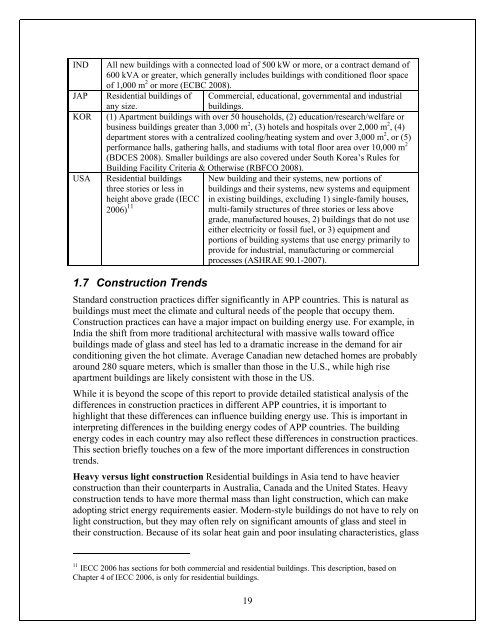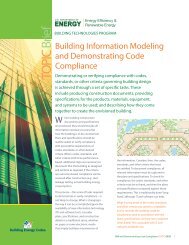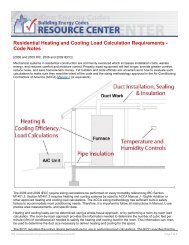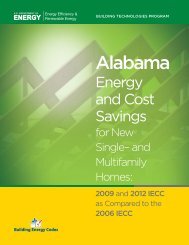Shaping the Energy Efficiency in New Buildings - Building Energy ...
Shaping the Energy Efficiency in New Buildings - Building Energy ...
Shaping the Energy Efficiency in New Buildings - Building Energy ...
Create successful ePaper yourself
Turn your PDF publications into a flip-book with our unique Google optimized e-Paper software.
INDJAPKORUSAAll new build<strong>in</strong>gs with a connected load of 500 kW or more, or a contract demand of600 kVA or greater, which generally <strong>in</strong>cludes build<strong>in</strong>gs with conditioned floor spaceof 1,000 m 2 or more (ECBC 2008).Residential build<strong>in</strong>gs of Commercial, educational, governmental and <strong>in</strong>dustrialany size.build<strong>in</strong>gs.(1) Apartment build<strong>in</strong>gs with over 50 households, (2) education/research/welfare orbus<strong>in</strong>ess build<strong>in</strong>gs greater than 3,000 m 2 , (3) hotels and hospitals over 2,000 m 2 , (4)department stores with a centralized cool<strong>in</strong>g/heat<strong>in</strong>g system and over 3,000 m 2 , or (5)performance halls, ga<strong>the</strong>r<strong>in</strong>g halls, and stadiums with total floor area over 10,000 m 2(BDCES 2008). Smaller build<strong>in</strong>gs are also covered under South Korea’s Rules forBuild<strong>in</strong>g Facility Criteria & O<strong>the</strong>rwise (RBFCO 2008).Residential build<strong>in</strong>gs <strong>New</strong> build<strong>in</strong>g and <strong>the</strong>ir systems, new portions ofthree stories or less <strong>in</strong> build<strong>in</strong>gs and <strong>the</strong>ir systems, new systems and equipmen<strong>the</strong>ight above grade (IECC <strong>in</strong> exist<strong>in</strong>g build<strong>in</strong>gs, exclud<strong>in</strong>g 1) s<strong>in</strong>gle-family houses,2006) 11 multi-family structures of three stories or less abovegrade, manufactured houses, 2) build<strong>in</strong>gs that do not useei<strong>the</strong>r electricity or fossil fuel, or 3) equipment andportions of build<strong>in</strong>g systems that use energy primarily toprovide for <strong>in</strong>dustrial, manufactur<strong>in</strong>g or commercialprocesses (ASHRAE 90.1-2007).1.7 Construction TrendsStandard construction practices differ significantly <strong>in</strong> APP countries. This is natural asbuild<strong>in</strong>gs must meet <strong>the</strong> climate and cultural needs of <strong>the</strong> people that occupy <strong>the</strong>m.Construction practices can have a major impact on build<strong>in</strong>g energy use. For example, <strong>in</strong>India <strong>the</strong> shift from more traditional architectural with massive walls toward officebuild<strong>in</strong>gs made of glass and steel has led to a dramatic <strong>in</strong>crease <strong>in</strong> <strong>the</strong> demand for aircondition<strong>in</strong>g given <strong>the</strong> hot climate. Average Canadian new detached homes are probablyaround 280 square meters, which is smaller than those <strong>in</strong> <strong>the</strong> U.S., while high riseapartment build<strong>in</strong>gs are likely consistent with those <strong>in</strong> <strong>the</strong> US.While it is beyond <strong>the</strong> scope of this report to provide detailed statistical analysis of <strong>the</strong>differences <strong>in</strong> construction practices <strong>in</strong> different APP countries, it is important tohighlight that <strong>the</strong>se differences can <strong>in</strong>fluence build<strong>in</strong>g energy use. This is important <strong>in</strong><strong>in</strong>terpret<strong>in</strong>g differences <strong>in</strong> <strong>the</strong> build<strong>in</strong>g energy codes of APP countries. The build<strong>in</strong>genergy codes <strong>in</strong> each country may also reflect <strong>the</strong>se differences <strong>in</strong> construction practices.This section briefly touches on a few of <strong>the</strong> more important differences <strong>in</strong> constructiontrends.Heavy versus light construction Residential build<strong>in</strong>gs <strong>in</strong> Asia tend to have heavierconstruction than <strong>the</strong>ir counterparts <strong>in</strong> Australia, Canada and <strong>the</strong> United States. Heavyconstruction tends to have more <strong>the</strong>rmal mass than light construction, which can makeadopt<strong>in</strong>g strict energy requirements easier. Modern-style build<strong>in</strong>gs do not have to rely onlight construction, but <strong>the</strong>y may often rely on significant amounts of glass and steel <strong>in</strong><strong>the</strong>ir construction. Because of its solar heat ga<strong>in</strong> and poor <strong>in</strong>sulat<strong>in</strong>g characteristics, glass11 IECC 2006 has sections for both commercial and residential build<strong>in</strong>gs. This description, based onChapter 4 of IECC 2006, is only for residential build<strong>in</strong>gs.19
















